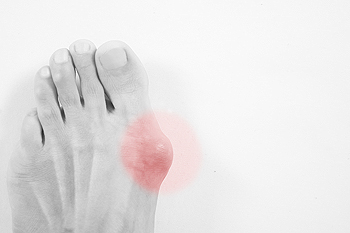
 A protruding bone at the base of the big toe is considered to be a deformity, and is referred to as a bunion. A common symptom of this condition consists of the big toe leaning in the direction of the other toes. This can force the bone to extend in the other direction. Genetics may play a significant role in developing a bunion, in addition to wearing shoes that do not have adequate room for the toes to move freely in. Existing medical conditions may contribute to the onset of a bunion, including gout and rheumatoid arthritis. Patients have found mild relief when a pad is worn over the bunion, which may help to prevent calluses from forming on top of it. For severe bunions, surgery may be necessary for permanent removal. If you are developing a bunion, it is advised that you are under the care of a podiatrist who can begin to promptly treat this condition.
A protruding bone at the base of the big toe is considered to be a deformity, and is referred to as a bunion. A common symptom of this condition consists of the big toe leaning in the direction of the other toes. This can force the bone to extend in the other direction. Genetics may play a significant role in developing a bunion, in addition to wearing shoes that do not have adequate room for the toes to move freely in. Existing medical conditions may contribute to the onset of a bunion, including gout and rheumatoid arthritis. Patients have found mild relief when a pad is worn over the bunion, which may help to prevent calluses from forming on top of it. For severe bunions, surgery may be necessary for permanent removal. If you are developing a bunion, it is advised that you are under the care of a podiatrist who can begin to promptly treat this condition.
If you are suffering from bunion pain, contact Dr. Alan J. Spector of Shore Podiatry. Our doctor can provide the care you need to keep you pain-free and on your feet.
What Is a Bunion?
Bunions are painful bony bumps that usually develop on the inside of the foot at the joint of the big toe. As the deformity increases over time, it may become painful to walk and wear shoes. Women are more likely to exacerbate existing bunions since they often wear tight, narrow shoes that shift their toes together. Bunion pain can be relieved by wearing wider shoes with enough room for the toes.
Causes
Symptoms
In order to diagnose your bunion, your podiatrist may ask about your medical history, symptoms, and general health. Your doctor might also order an x-ray to take a closer look at your feet. Nonsurgical treatment options include orthotics, padding, icing, changes in footwear, and medication. If nonsurgical treatments don’t alleviate your bunion pain, surgery may be necessary.
If you have any questions, please feel free to contact our office located in Point Pleasant, NJ . We offer the newest diagnostic and treatment technologies for all your foot care needs.